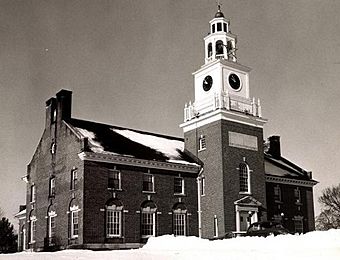Good Will-Hinckley facts for kids
Quick facts for kids |
|
|
Hinckley Good Will Home Historic District
|
|

1916 photo of the Prescott Administration Building
|
|
| Lua error in Module:Location_map at line 420: attempt to index field 'wikibase' (a nil value). | |
| Location | US 201, Hinckley, Maine |
|---|---|
| Area | 525 acres (212 ha) |
| Built | 1889 |
| Architect | Wilfred E. Mansur (Moody Chapel, 1897) William R. Miller (Moody Hall, 1905–06) Edward Josselyn (Prescott Administration building, 1916) Albert Randolph Ross (Carnegie Library, 1906-07) |
| Architectural style | Colonial Revival, Queen Anne |
| NRHP reference No. | 87000232 |
| Added to NRHP | January 9, 1987 |
Good Will-Hinckley is a special organization in Fairfield, Maine. It started in 1889 thanks to George W. Hinckley. This group helps young people learn and grow. It has a large campus, over 600 acres, in Fairfield.
On this campus, you'll find the Maine Academy of Natural Sciences. This is a school where students can live or attend during the day. It focuses on learning about farming and outdoor activities. There's also the Glenn Stratton Learning Center. This school helps kids who are working through social, emotional, or behavior challenges. Good Will-Hinckley is also home to the L. C. Bates Museum. This is one of Maine's oldest museums about nature. The organization also provides homes for students from the Maine Academy, college students, and young people needing extra support.
Contents
The Story of Good Will-Hinckley
How It All Began
The Good Will Home Association started in 1889. It was founded by George Walter Hinckley. He was a man who trained to be both a minister and a teacher. When he was young, he saw how much a good, caring environment could help young people. Especially those who were struggling or didn't have many advantages.
So, he decided to create a special home for them. He started on a 125-acre farm in a quiet part of Fairfield, Maine. Mr. Hinckley worked hard to raise money for the Good Will School. By the time he passed away in 1950, the campus had grown huge. It was 3,000 acres with 45 buildings. It had helped over 3,000 young people who needed support.
Changes Over Time
Later, the organization, then called the Hinckley School, started to focus on preparing students for college. This was similar to other well-known schools. However, the state of Maine felt this was different from its original purpose.
In 1970, the organization was asked to return to its first mission. This meant helping a wider range of young people. The school stopped its main operations in 2009. This happened because state funding for boarding schools changed. But the day treatment program continued. The organization worked hard to reorganize. Today, Good Will-Hinckley helps young people from all over Maine. It gives them chances to learn and provides a safe place to live.
What Good Will-Hinckley Does Today
Good Will-Hinckley is a non-profit group. It continues George Hinckley's important work. The organization runs five main programs on its 600-acre campus:
- Maine Academy of Natural Sciences: This is a special high school. It's for students who might not do well in regular school settings. It focuses on nature and hands-on learning.
- Glenn Stratton Learning Center: This is a day program. It helps children with social, emotional, and behavior challenges.
- L. C. Bates Museum: This museum teaches about natural history.
- Roundel Residential Treatment program: This program helps young people who are facing big social, emotional, and behavior challenges. It gives them a supportive home and treatment.
- College Step Up and Transitional Living program: This program offers year-round housing and support. It helps young people attending college or those who need help finding jobs and stable homes.
The organization also provides homes on campus. This is for students from the Maine Academy of Natural Sciences who live far away. It's also for those who need a different home environment.
Exploring the Campus
Historic Buildings and Design
The Good Will-Hinckley campus is in northeastern Fairfield. It's located on the west side of United States Route 201. A stream called Martin Stream runs through it. Historically, the campus was split. The girls' campus was on the north side, and the boys' campus was on the south.
The main historic part of the campus covers about 525 acres. It includes all the buildings built between 1889 and 1930. This area was recognized as a historic place in 1987. The campus has many unique homes for students. These are spread out along Page Terrace. There are also several other important buildings designed by famous architects.
Notable Campus Structures
- The Moody Chapel was built in 1897. It was designed by Wilfred E. Mansur from Bangor, Maine.
- The Moody School was built between 1905 and 1906. William R. Miller from Lewiston, Maine designed it.
- The Prescott Administration building was built in 1916. Edward Josselyn, an architect from New York City, designed this building.
- The Carnegie Library was built in 1906-1907. It was designed by Albert Randolph Ross from New York. This library was built with money from Andrew Carnegie.
- Edward Josselyn also designed the woodworking shop in 1919.
- William R. Miller designed the building that now houses the L. C. Bates Museum.
See also

